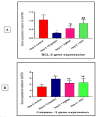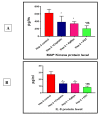In Vitro Differential Sensitivity of Head and Neck Squamous Cell Carcinoma to Cisplatin, Silver Nanoparticles, and Photodynamic Therapy
- PMID: 36164632
- PMCID: PMC9455178
- DOI: 10.52547/rbmb.11.2.224
In Vitro Differential Sensitivity of Head and Neck Squamous Cell Carcinoma to Cisplatin, Silver Nanoparticles, and Photodynamic Therapy
Abstract
Background: The clinical effect of photodynamic therapy (PDT) may be correlated with the degree of dysplasia of cancer tissues. The aim of this study was to compare the effects of cisplatin, silver nanoparticles (AgNps), and photodynamic therapy (PDT) using methylene blue (MB) photosensitizer on Head and Neck squamous cell carcinoma - cell line (HNSCC), Hep-2, through genes expression.
Methods: Hep-2 cells were divided into four groups: group I as control and without any treatment, group II and III were treated by cisplatin and AgNps, respectively, and group IV were incubated with MB for four minutes followed by PDT using laser irradiation at 650 nm for 8 minutes. The resulting toxicity was assessed in cell lines using MTT cytotoxicity assay. Further, apoptosis and the response to treatment was examined via RT-qPCR.
Results: MB-PDT inhibited the proliferation of Hep-2 cells. Following PDT, compared with AgNps cells and via MTT assay, a highly significant decrease was observed in cell proliferation in Cancer cells treated with AgNps and MB- PDT groups compared to cancer group cells and cancer cells treated with Cisplatin (p value< 0.001). Mechanistically, both the mRNA and protein expression levels of Bcl-2, Caspase-3, Cyclin-D, HIF-1, IL-8, MAPK-38, and ROS were found to be down regulated in Hep-2 cell line after MB-PDT.
Discussion: MB-PDT effectively killed Hep-2 cells in vitro, however, under the same conditions, the susceptibilities of the cell line to cisplatin, AgNps, and MB-PDT were different. Further studies are necessary to confirm whether this difference is present in clinical oral cancer lesions.
Keywords: Head and Neck squamous cell carcinoma (HNSCC); Methylene Blue (MB); Photosensitizer (PS); photodynamic therapy (PDT); silver nanoparticles (AgNps).
Figures







References
-
- Jiashing Yu, Chih-Chia H, Po-Yang Ch. Development of therapeutic Au–methylene blue nanoparticles for targeted photodynamic therapy of cervical cancer cells. ACS Appl Mater Interfaces. 2014;7(1):432–41. - PubMed
-
- Ferlay J, Soerjomataram I, Dikshit R, Eser S, Mathers C, Rebelo M. Cancer incidence and mortality worldwide: sources, methods, and major patterns in GLOBOCAN 2012. Int J Cancer. 2015;136(5):E359–86. - PubMed
LinkOut - more resources
Full Text Sources
Research Materials
Miscellaneous
